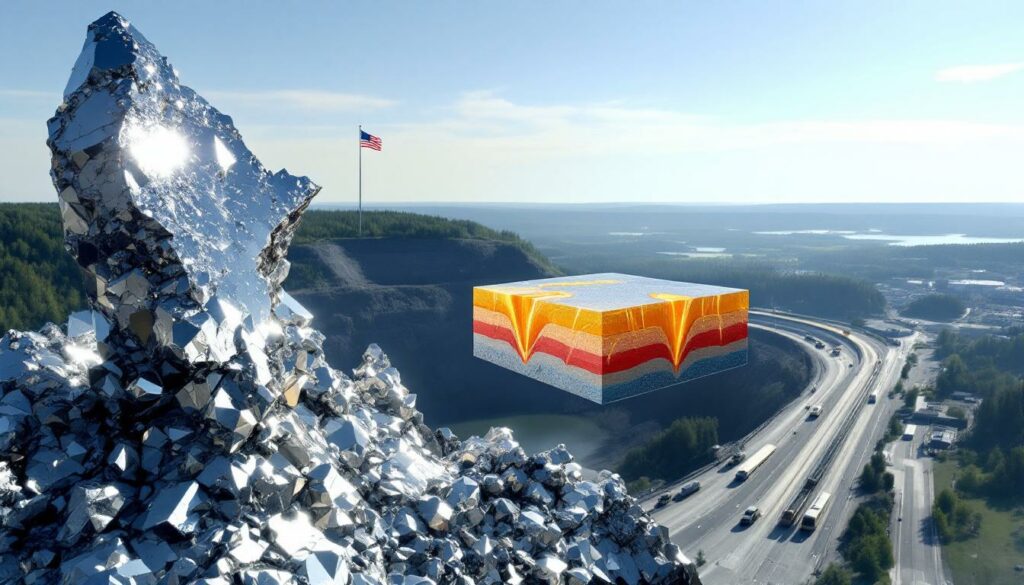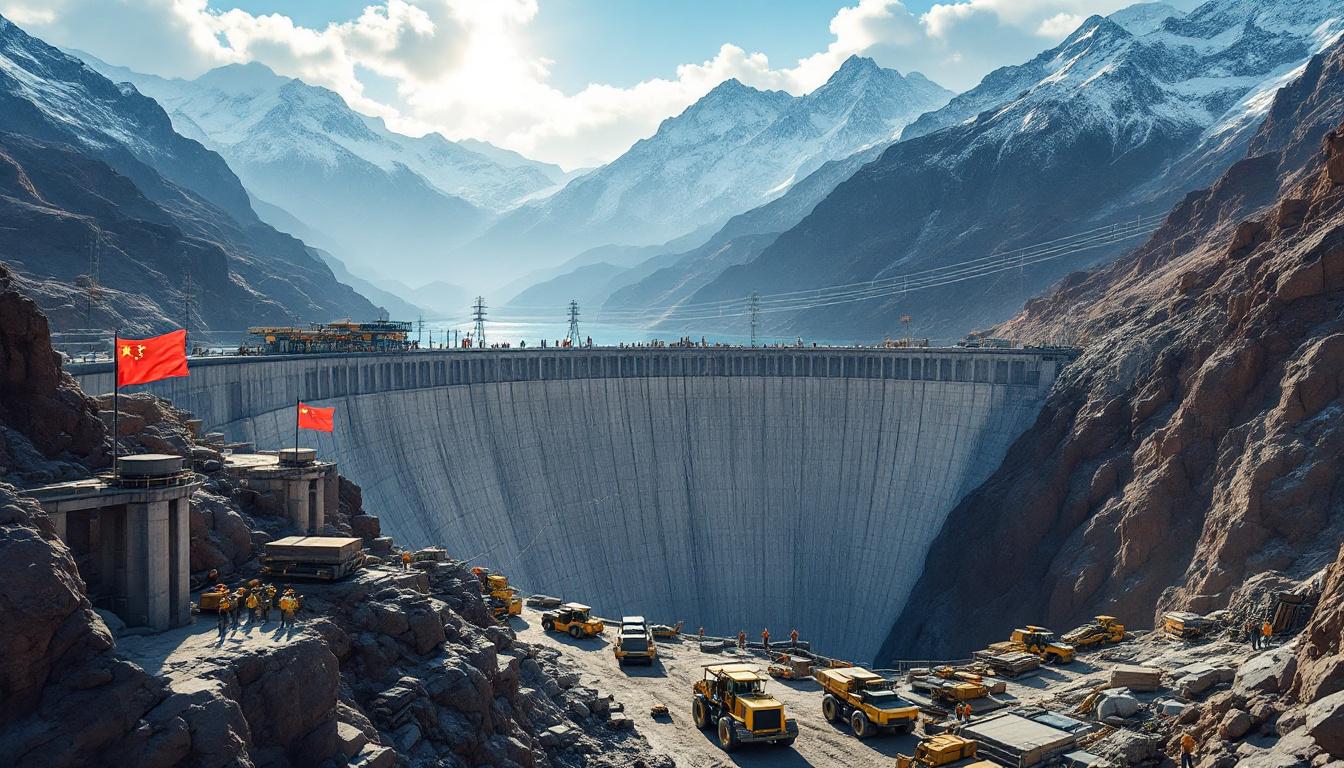What Is the Tamarack Nickel Project? Understanding America's Next Major Nickel Development
The global race for critical minerals has intensified dramatically in recent years, with nickel playing a crucial role in energy transition technologies. While demand continues to climb, high-grade nickel discoveries in geopolitically stable jurisdictions have become increasingly rare. The Tamarack Project in Minnesota has emerged as one of North America's most promising nickel developments, potentially positioning the United States to reduce its heavy reliance on imported nickel for battery manufacturing and other critical applications.
According to recent data from the U.S. Geological Survey, the United States currently imports approximately 50% of its nickel requirements, highlighting the strategic importance of domestic production capability. With EV battery demand projected to increase tenfold by 2030, securing stable critical minerals demand has become a national priority under the Critical Minerals Strategy.
The Strategic Importance of Domestic Nickel Production
The significance of Tamarack extends beyond its impressive geology. As countries worldwide compete for access to battery metals investment, developing domestic sources of high-grade nickel provides both economic and national security advantages.
"The race for critical minerals is heating up by the day, but the pace of new discoveries has never been slower. High grade, large tonnage deposits on friendly soil are extraordinarily rare," notes Ian Burron of Geology for Investors.
The Tamarack Project represents a potential cornerstone in America's efforts to establish resilient supply chains for the energy transition security. With recent drilling revealing exceptional grades rarely seen in global nickel exploration, industry experts have begun comparing Tamarack's potential to world-class nickel districts.
Where Is the Tamarack Project Located?
The Tamarack Project is strategically positioned in central Minnesota, approximately 89 kilometers west of Duluth and 210 kilometers north of Minneapolis. This location offers significant logistical advantages that enhance the project's development potential.
Geographic Setting and Infrastructure Advantages
The project benefits from exceptional infrastructure, including:
- Extensive railway network connectivity providing direct transport routes
- Well-maintained paved road access throughout the property
- Proximity to major industrial centers in Minnesota's mining heartland
- Access to a skilled mining workforce with generations of experience
- Location within a historically mining-friendly region with processing capability
The project area encompasses the small town of Tamarack (population 62), though the settlement itself sits outside the zones of known mineralization. This isolation helps mitigate potential community impact concerns while maintaining the accessibility benefits.
The property is divided into two main sections: Tamarack North, which contains the established resource and has been the focus of intensive drilling campaigns, and Tamarack South, which remains less thoroughly explored but holds substantial potential based on preliminary surveys.
Who Controls the Tamarack Project?
The development and future of the Tamarack Nickel Project rests in the hands of a powerful joint venture between an emerging mining company and one of the world's largest diversified miners.
Ownership Structure and Development Rights
The project operates under a joint venture structure with:
- 51% owned by Talon Nickel (USA) LLC, a wholly-owned subsidiary of Talon Metal Corp
- 49% owned by Kennecott Exploration Company (a Rio Tinto subsidiary)
- Talon possessing the right to increase its stake to 60% through an earn-in agreement
This partnership combines Talon's development focus with Rio Tinto's global mining expertise and financial capacity. Rio Tinto brings exceptional technical capabilities from operations like Kennecott Copper (Utah) and the Diavik diamond mine (Canada), while Talon provides the nimble project advancement needed in the current critical minerals landscape.
A feasibility study is currently underway and must be completed by November 7, 2025, for Talon to exercise its option to increase its ownership stake. This deadline creates a clear development timeline for the project.
Some project claims are subject to royalties ranging from 2-3.9%, which will affect overall project economics but are within typical ranges for comparable developments in North America.
What Makes Tamarack's Geology Exceptional?
The Tamarack Project's extraordinary potential stems from its unique geological setting and formation processes. The deposit represents a textbook example of magmatic nickel sulfide formation, but with unusually high metal concentrations.
The Tamarack Intrusive Complex
The project's mineralization is hosted within the Tamarack Intrusive Complex (TIC), a unique geological formation that resembles a tadpole in shape:
- A rounded "body" approximately 4 kilometers wide
- A thin, 7-kilometer-long "tail" extending northward
- All known significant mineralization concentrated within this northern tail section
The TIC formed approximately 1.1 billion years ago during the Mid-Continent Rift, a massive geological event that nearly split North America in half. This ancient rift created the perfect conditions for ultramafic magma to rise from deep within the Earth, bringing with it metal-rich material.
Dr. Sarah Miller, structural geologist with expertise in the Mid-Continent Rift system, explains: "The rifting process created deep crustal faults that served as perfect conduits for metal-rich magma. What makes Tamarack special is that these magmatic systems were the perfect size—large enough to mobilize significant metal volumes but small enough to concentrate them in accessible positions."
Formation of High-Grade Nickel Mineralization
Tamarack represents a classic magmatic sulfide deposit, formed through a specific geological process:
- Metal-rich mafic/ultramafic magma became saturated with sulfur (likely from surrounding sulfur-rich sedimentary rocks)
- This saturation caused metals like nickel, copper, platinum, and gold to bind with sulfur
- The resulting sulfide melt separated from the silicate magma (similar to oil separating from water)
- Sulfide droplets scavenged additional metals from surrounding magma
- The dense sulfide melt sank and accumulated in low spots, forming concentrated metal-rich bodies
The TIC developed in at least two distinct phases:
- A large, fine-grained orthocumulate intrusion (FGO) forming most of the southern section
- A slightly later coarse-grained orthocumulate (CGO) dyke-like intrusion in the north
Mineralization primarily occurs at the contact between these two rock types and at boundaries with surrounding sedimentary rocks. The FGO is believed to have been a magma conduit and the primary source of mineralization.
What differentiates Tamarack from many other magmatic sulfide deposits is the unusually high concentration of metals in the sulfide bodies. This suggests either an exceptionally metal-rich source magma or an extremely efficient metal scavenging process during formation.
How Significant Are Tamarack's Mineral Resources?
The true significance of the Tamarack Project continues to evolve as exploration reveals increasingly impressive mineralization. While the established resource provides a solid foundation, recent drilling suggests the ultimate potential may be far greater.
Current Resource Estimates
The Tamarack Project's established mineral resources include:
| Classification | Tonnage (Mt) | NiEq (%) | Ni (%) | Cu (%) | Co (%) | PGE+Au (g/t) | Recoverable Fe (%) |
|---|---|---|---|---|---|---|---|
| Indicated | 8.564 | 2.34 | 1.73 | 0.92 | 0.05 | 0.72 | 8 |
| Inferred | 8.461 | 1.19 | 0.83 | 0.55 | 0.02 | 0.49 | 3 |
These figures represent only three of the mineralized zones (the Massive Sulfide Unit, Semi-Massive Sulfide Unit, and 138 zones) and exclude several newly discovered areas and less well-defined mineralized zones.
It's important to note that this resource estimate dates to 2022 and does not include the remarkable discoveries made in 2025, suggesting an updated resource estimate may show significant expansion.
Recent High-Grade Discoveries
The project's potential has expanded dramatically with recent drilling results. In May 2025, Talon Metals made a historic discovery, announcing extraordinary new findings:
- An intercept of 8.25 meters grading 12.62% Ni, 13.88% Cu, and 17.95 g/t PGEs+Au (23.28% NiEq)
- A follow-up hole with two zones of massive sulfide totaling 34.9 meters at 14.86% Ni, 15.37% Cu, 0.11% Co, 9.18 g/t Au, 16.31 g/t Pt, 8.65 g/t Pd, and 42.92 g/t Ag (28.88% NiEq)
For context, most nickel mines globally operate at grades below 2% Ni. These intercepts lie outside previously known mineralization, suggesting Tamarack's potential may be substantially greater than initially understood.
"These grades are frankly astonishing," comments mining analyst James Chen. "Finding a 35-meter zone grading nearly 15% nickel is almost unheard of in modern exploration. For comparison, many operating nickel mines consider 1% ore to be good grade."
The combination of high grades across multiple metals (nickel, copper, cobalt, precious metals) creates exceptional in-situ value per ton, potentially allowing for economic extraction even in challenging mining conditions.
What Are Tamarack's Exploration Upside Opportunities?
Beyond the established resource areas, Tamarack offers multiple exploration targets that could substantially increase the project's overall scale and economic potential.
The Raptor Zone
Beyond the established resource areas, Talon has identified the promising Raptor Zone:
- Strike length exceeding 250 meters
- Intercepts up to 5.93 meters at 4.09% NiEq
- Intriguingly hosted within the CGO intrusion, suggesting this formation may contain significant mineralization contrary to earlier interpretations
The significance of the Raptor Zone extends beyond its immediate resource potential. Its location within the CGO intrusion challenges previous geological models that suggested this rock type was largely barren of economic mineralization. This opens up vast new areas of the property for exploration, potentially multiplying the project's resource base.
Deep Exploration Targets
Magnetotelluric (MT) surveys have identified a massive anomaly approximately:
- 900 meters below the current Tamarack resource area
- 1,500 meters below surface
Limited drilling of these deep targets has yielded promising indications, including clasts of massive sulfides that may represent droplets in the process of sinking to a deeper, potentially larger sulfide pool. While these deep targets show tremendous potential, Talon is not planning to drill them in the current 2025 campaign.
Geophysicist Dr. Elena Rodriguez explains: "MT surveys are particularly effective at identifying conductive bodies like massive sulfides at depth. The size and intensity of the anomaly at Tamarack suggests a substantial accumulation of conductive material—potentially a major sulfide body. The presence of massive sulfide clasts in overlying rocks supports this interpretation."
Tamarack South Potential
The majority of the Tamarack Intrusive Complex lies within the less-explored Tamarack South area. Initial drilling has identified:
- Widespread low-grade sulfide mineralization
- Occasional small high-grade intercepts
- Vast volumes of prospective rock remaining untested
The exploration strategy for Tamarack South will likely be guided by the evolving geological understanding from Tamarack North. The identification of key structural controls and mineralization indicators could accelerate discovery in this underexplored region.
How Was Tamarack Discovered?
The story of Tamarack's discovery illustrates the importance of scientific curiosity, persistence, and evolving geological understanding. Unlike many major mineral discoveries that happened by chance, Tamarack emerged through methodical exploration guided by advancing geological science.
The Exploration Timeline
The discovery and development of Tamarack provides an instructive case study in persistence and scientific advancement:
- 1984: Minnesota Geological Survey discovers the TIC while drilling a magnetic anomaly (purely for scientific research)
- Late 1990s: Improved understanding of magmatic deposits renews interest in the TIC
- 2000: Kennecott leases the property based on magnetic and lake sediment anomalies
- 2002: Initial drilling begins, finding only low-grade disseminated mineralization
- 2008: First significant massive sulfide mineralization intercepted
- 2020: Talon takes over drilling operations
- 2021-2022: Intensive drilling campaigns (33,375m in 2021, 24,508m in 2022)
- 2022: Maiden resource estimate published
- 2025: Major high-grade discoveries announced
The project area is covered by 35-55 meters of glacial sediment with no exposed bedrock, making exploration particularly challenging. Early scientific thinking suggested magmatic sulfide deposits couldn't form in such small intrusions, but improved geological understanding eventually led to the recognition of Tamarack's potential.
"The Tamarack discovery represents a triumph of modern geoscience," notes Dr. Robert Johnson, economic geologist. "Thirty years ago, we wouldn't have recognized the potential of this system. The evolution in our understanding of how magmatic sulfides form allowed us to see the opportunity that was literally buried beneath our feet."
This long timeline from initial discovery to resource definition highlights the patience required in mineral exploration. The recent acceleration in development reflects both improved understanding of the deposit and the growing strategic importance of domestic nickel resources.
What Challenges Does Tamarack Face?
Despite its exceptional geological potential, the Tamarack Project faces significant hurdles on its path to production. These challenges will test both the project developers and America's commitment to domestic critical mineral development.
Regulatory and Environmental Considerations
While Tamarack's geological potential is extraordinary, the project faces significant challenges:
- Located in a region historically resistant to mining development
- Complex regulatory environment requiring multiple permits
- Strong environmental advocacy presence in the Great Lakes region
- Need to demonstrate responsible environmental stewardship
- Community engagement requirements
The Great Lakes region has become notoriously difficult for mining project development, with multiple projects facing extended delays or outright rejection. The nearby New Range (formerly PolyMet) copper-nickel project has been entangled in regulatory and legal processes for over 15 years, highlighting the potential for significant delays.
Environmental attorney Michelle Garcia explains: "Mining projects in the Great Lakes watershed face heightened scrutiny due to the ecological importance of the region. Successful development requires not just compliance with regulations, but exceeding them—demonstrating a commitment to environmental protection that goes beyond the minimum requirements."
These challenges will test America's critical minerals strategy and the balance between resource development and environmental protection. The project's advancement will likely depend on:
- Demonstrating best-in-class environmental management
- Securing community support through transparent engagement
- Navigating complex regulatory frameworks
- Highlighting the strategic importance of domestic nickel production
The contrast between Tamarack's world-class geology and the challenging jurisdiction highlights a growing tension in nickel industry challenges—the best deposits aren't always in the most favorable locations for development.
How Does Tamarack Compare to Global Nickel Projects?
In the competitive landscape of global nickel development, Tamarack stands out for both its exceptional grades and strategic location, despite jurisdictional challenges.
Competitive Positioning
The Tamarack Project's recent high-grade discoveries place it among an elite group of nickel developments globally:
- Grade: The recent intercepts exceeding 14% nickel rank among the highest-grade undeveloped nickel resources worldwide
- Size: While the full extent remains to be determined, the project shows potential to become a significant district-scale development
- Location: Situated in a politically stable jurisdiction with excellent infrastructure
- Metallurgy: Preliminary work indicates favorable processing characteristics
- Strategic importance: Positioned to supply critical battery materials to the North American supply chain
When compared to other developing nickel projects, Tamarack's grade advantage is particularly striking. Most current development projects globally are pursuing resources below 1% nickel, often in laterite deposits that require energy-intensive pressure acid leaching for processing.
Mineral economist Dr. James Wilson provides context: "High-grade sulfide nickel is the gold standard for battery metals. It's typically cheaper to process, has a lower carbon footprint, and produces a cleaner product. Finding grades above 10% in a stable jurisdiction is exceedingly rare—there might be fewer than five undeveloped deposits globally with comparable characteristics."
The only comparable undeveloped high-grade nickel sulfide deposits of significant scale are found in challenging jurisdictions like Russia, or in difficult-to-access locations like deep underground in Canada or Australia. Furthermore, Indonesian nickel trends are increasingly dominating global supply, making Tamarack's potential even more
Ready to Stay Ahead of Major Mineral Discoveries?
Don't miss the next market-moving discovery announcement on the ASX. Discovery Alert's proprietary Discovery IQ model provides instant notifications when significant mineral discoveries are announced, giving you the edge to make informed investment decisions. Visit Discovery Alert's discoveries page to see how historic discoveries have delivered exceptional returns.




